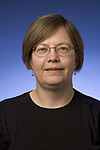Wyatt Merritt, Particle Physics Division, retires today
 |
|
Wyatt Merritt
|
Scientist Wyatt Merritt first came to Fermilab 41 years ago not as an employee, but as a scientific user on neutrino experiments. Nine years later she joined the laboratory staff. Now, after 32 years as a Fermilab scientist on numerous projects, Merritt is retiring. Her last day is today.
Merritt's career has spanned the gamut of Fermilab's scientific programs and project roles: She has worked on projects in collider, neutrino, muon and dark energy physics. She has helped build detector components, analyzed data, written simulation and analysis software, and led and managed projects.
Merritt began her career at Fermilab as a postdoc, building three-wire drift chambers and taking and analyzing data for neutrino experiments in Lab E.
After transitioning to regular employee at the laboratory, she began work on the DZero experiment. During her time on DZero, she developed reconstruction and simulation software and conducted physics analyses for searches of leptoquarks. She eventually took on DZero leadership roles, serving as New Phenomena Group convener, Run II Computing and Software co-leader, DZero Computing and Analysis Department head in the Computing Division, and SAM Data Handling Project co-leader.
She earned an Employee Achievement Award in 2002 for her part in computing during Run II of the Tevatron.
A proven effective leader, she went on to assume deputy project manager roles for the DECam and Muon g-2 projects.
Merritt was also one of several founding members of the Women Scientists mailing list, which was used for several decades to bring women scientists together for a monthly lunch. It is still used to alert the women scientists and engineers in the lab community to events and issues of interest.
Having given so much to Fermilab, Merritt leaves her mark on many aspects of the laboratory's discovery efforts. Now a Fermilab scientist emeritus, she will continue to contribute to the Dark Energy Survey.
She and her husband plan to spend more time traveling after she retires.
"It has been fantastic to work with so many creative, knowledgeable and dedicated people at the lab and in our user community," Merritt said. "I am glad to have been a part of some of the physics and the technical achievements here for so long. Time to move on now, though!"
|